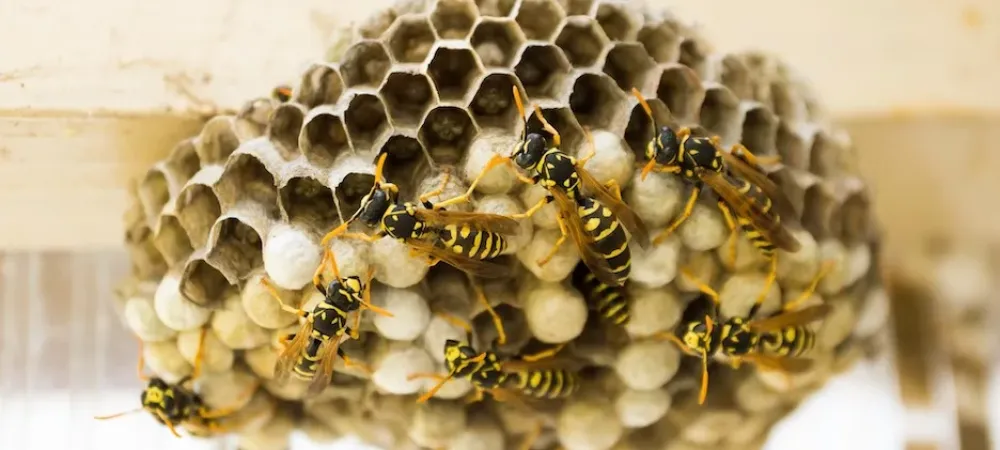How To Get Rid of A Wasp Nest Without Getting Stung

Wasps are known for their painful stings, and if you have a wasp nest in or near your home, it can be a dangerous situation. It's important to take necessary precautions when getting rid of a wasp nest to avoid getting stung. In this blog post, we'll discuss how to recognize a wasp’s nest, how to remove the nest safely, and how to prevent wasps from coming back.
What Does a Wasp Nest Look Like?
Before we discuss how to get rid of a wasp nest, it's important to know what a wasp nest looks like. Wasp nests can vary in size and shape depending on the species of wasp. However, most wasp nests are papery, greyish, or brownish in color, and have a honeycomb-like structure. Wasp nests can be found in various locations, such as trees, shrubs, eaves of houses, attics, and garages.
How To Safely Remove A Wasps Nest
Getting rid of a wasp nest can be a dangerous task, and it's important to take necessary precautions to avoid getting stung. Here are some tips to get rid of a wasp nest without getting stung:
- Wear Protective Clothing: When removing a wasp nest, it's important to wear protective clothing, such as long-sleeved shirts, pants, gloves, and a hat. This will help protect your skin from the wasp's stingers.
- Plan Your Attack: Before removing the wasp nest, it's important to plan your attack. Make sure you have an escape route in case the wasps become agitated. It's also important to remove the wasp nest at night when the wasps are less active.
- Use a Wasp Killer Spray: Wasp killer sprays can be purchased at most hardware stores. It's important to follow the instructions on the spray can and spray the nest from a safe distance. It's also important to spray the nest until it's completely saturated.
- Use a Vacuum Cleaner: If the wasp nest is located in a confined space, such as an attic or garage, a vacuum cleaner can be used to remove the wasps. Make sure to use a vacuum cleaner with a long hose and nozzle attachment to keep a safe distance from the wasps.
- Physical Removal: If the wasp nest is small and easily accessible, you may be able to physically remove it. Use a long stick or pole to knock down the nest and then place it in a sealed plastic bag.
- Call a Professional: If you're unsure about how to get rid of a wasp nest or if the wasp nest is located in a hard-to-reach area, it's best to call a professional pest control company. They have the proper equipment and training to safely remove the wasp nest.
Calling a professional wasp exterminator is also your best option if you know you are allergic to stinging insects or have children on your property.
Remember to dispose of the wasp nest properly by placing it in a sealed plastic bag and disposing of it in a garbage can that's located away from your home.
How To Prevent Wasps From Returning
Preventing wasps from returning after removing their nest is an important step to take to avoid future infestations. Here are some tips to prevent wasps from returning:
- Seal Entry Points: Wasps can enter your home through small cracks and openings. Inspect your home and seal any entry points to prevent wasps from entering.
- Keep Food Covered: Wasps are attracted to sweet smells and can become aggressive when they sense food or sugary drinks. Keep your food and drinks covered to reduce the risk of attracting wasps.
- Clean Up Spills: Clean up spills and crumbs promptly, especially outdoors where wasps are more likely to gather. Wasps are attracted to sweet and sugary substances, so keeping your outdoor areas clean can reduce the risk of attracting them.
- Use Natural Wasp Repellents: Certain herbs, such as basil, mint, and eucalyptus, have a strong scent that repels wasps. Plant these herbs around your property to keep wasps away.
- Spray Peppermint Oil: Wasps are repelled by the scent of peppermint oil. Mix 10-15 drops of peppermint oil with water and spray the solution around areas where wasps are known to gather. Vinegar can also be mixed in equal parts with water to make a wasp-repellent spray, though many homeowners find the smell unpleasant.
- Burn Citronella Candles: The scent of citronella oil is known to repel wasps. Light citronella candles around your property to keep wasps away.
- Hang Fake Nests: Wasps are territorial and will avoid areas where there are already established nests. Hang a fake wasp nest in a visible area to trick them into thinking there is already a nest on your property.
- Use Wasp Traps: Wasp traps can be used to capture and kill wasps. Place the traps around areas where wasps are known to gather, such as near garbage cans or outdoor dining areas.
If you're unsure about how to prevent wasps from returning, or if you're dealing with a large infestation, it's best to call a professional pest control company. They can provide you with advice on how to prevent future infestations and may be able to recommend additional methods for preventing wasps from returning.
If you live in the DC, Virginia, or Maryland area, we encourage you to contact Senate Termite & Pest Control. Our wasp removal program includes same-day and next-day treatments, as well as 24/7 phone lines for around-the-clock support.
Here are some additional questions our wasp exterminators have received when it comes to removing the nests of stinging insects.
What Time of Day Is The Best To Remove A Wasp Nest?
It is best to remove a wasp nest during the evening or early morning hours when the majority of the wasps are likely to be in their nest.
Should I Remove A Wasp Nest Or Leave It?
It is generally not advisable to remove a wasp nest on your own, as this could potentially lead to being stung by the insects. If there is an active nest, it is recommended that you contact a pest control professional who specializes in safely removing and disposing of wasp nests. They will have the appropriate tools and protective gear needed to remove the nest safely.
What Do I Do With A Wasp Nest After I Knocked It Down?
After a wasp nest has been knocked down, it is important to properly dispose of it. The safest and most effective way to do this is to place the nest in a sealed plastic bag and throw it away in an outdoor trash can that cannot be accessed by children or pets. Be sure to wear protective clothing while handling the nest, as some wasps may still be alive and may sting if disturbed. If the nest cannot be safely disposed of, it should be left in an isolated area away from humans or animals.
It is also important to remember that a single nest can have multiple generations of wasps living in it, so even if the nest has been knocked down, wasps may still be living in the area.

